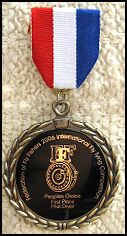The Raptor
By Richard Komar
The Raptor originally was designed as a proof-of-concept
fly to test the large hook holding and tying capability
of the Dingo Mark II rotary vice from Australia. The
test was successful and sparked the creation of other
Raptors for actual fishing conditions, both freshwater
and saltwater.
The erect dorsal fin area uses Whiting American Rooster
Saddles. For the underbody, Conranch Rooster Saddles
are preferred for their long hackles and undulating fin
effects. Siskiyou Aviary Super Spey Rhea Hackle is used
in the gill area for its length and vivid color.
The Raptor is tied in six easy steps and you don't need
any magnifiers to tie it! The Raptor shown is 9 inches
long and 9 inches tall. Ribbing wire can be added around
the body chenille and metal dumbbell eyes can be
substituted for the doll eyes for more durability,
especially when the Raptor has to hold its own against
toothy adversaries!
Materials List:
Hook: Mustad 3407SS Shark Hook, 12/0.
Top Hackle: Whiting American Rooster Saddles,
Black, Black-Laced White.
Bottom Hackle: Conranch Rooster Saddles, Black, Silver Badger.
Throat: Siskiyou Aviary Super Spey Rhea Hackle, Red.
Body: Large Estaz Chenille, Opal Black.
Thread: Gudebrod, Black, size G.
Eyes: Plastic Doll Eyes, 12mm.
Instructions - The Raptor:

1. Lay a spiral thread base along most of the length
of the hook shank. Tie in the Estaz chenille at the
top of the hook bend as an anchor point for the tail.
Tie in a pair of black-laced white American Rooster
saddles, concave sides facing each other, on top of
the hook. Tie in a pair of silver badger Conranch
Rooster saddles, the same way, underneath the hook.
Wrap the chenille forward of the tie-in point about
½ inch.

2. Tie in another pair of black-laced white American
Rooster saddles and silver badger Conranch Rooster
saddles as in Step 1. Wrap the chenille forward of
the tie-in point about ½ inch.

3. Tie in one more pair of black-laced white American
Rooster saddles and silver badger Conranch Rooster saddles
as in Step 1. Again, wrap the chenille forward of the
tie-in point about ½ inch.

4. Tie in a final pair of black American Rooster saddles
and black Conranch Rooster saddles as in Step 1. One more
time, wrap the chenille forward of the tie-in point, but
this time only ¼ inch, tie off and trim.

5. Tie in about a dozen strands of long red Siskiyou Aviary
Super Spey Rhea hackle stems, sloping downward.

6. Layer-wrap a large thread base to the hook eye; tie off
and whip finish (epoxy if desired). Glue on a pair of doll
eyes on this thread base. The Raptor is now ready to fish!

How to Fish the Raptor:
The Raptor should feel at home both in the saltwater and
freshwater. It is meant to emulate a mullet, flying fish
or any large baitfish. The freshwater Raptor can also
be tied in a red and white motif for muskies and northern
pike, or in olive, black and white to look like juvenile
largemouth bass for big, hungry adult largemouths.
Needless to say, one needs a heavy-duty outfit to cast
the Raptor. At least a 12 weight (14 weight?). It
easily matches up with wire tippet. Don't plan on
fishing such a large fly? The Raptor gives new meaning
to the words "dinner fly plate!" If you are a tyer looking
for a challenge, a tyer tying for really large game fish
or one tying that ultimate gift for another fly angler,
then the Raptor is the fly for you!
Oh yes, can you find the size 32 soft-hackle fly in
the above photograph? The size 32 was also tied as a
proof-of-concept fly on the Australian Dingo vice.
Tight Lines! ~ Richard
 A Special Note:
A Special Note:
Last April '05, I submitted some flies for the
Federation of Fly Fishers 2006 International Fly
Tying Competition. The Raptor, above, was one of
the entries. They didn't have a saltwater-type
category for it, but they did have a pike diver
category. So...I tied one in a pike-attracting
motif of orange and yellow, put it in frame and
sent it along with four other flies.
Yesterday, I got this nondescript envelope from
Rigby, Idaho. I open it up and out falls this
2 1/2" medal! No letter or anything, no fanfare,
just the medal. I immediately knew which fly won!
I think these winning flies will be on permanent
display at the FFF Museum in Livingston.
So, I just thought you would like to know that an
FAOL FOTW won a medal in an international flytying
competition! Maybe this could encourage more FOTW
submittals? (09/16/06)
About Richard:
Richard Komar is a flyfisher and fly tyer in Plano,
Texas and a member of the Dallas FlyFishers. Richard
is dreaming of that perfect trip to the Texas Gulf
Coast in search of the next IGFA record. Maybe the
Raptor is the fly that will make that dream come true!
|



